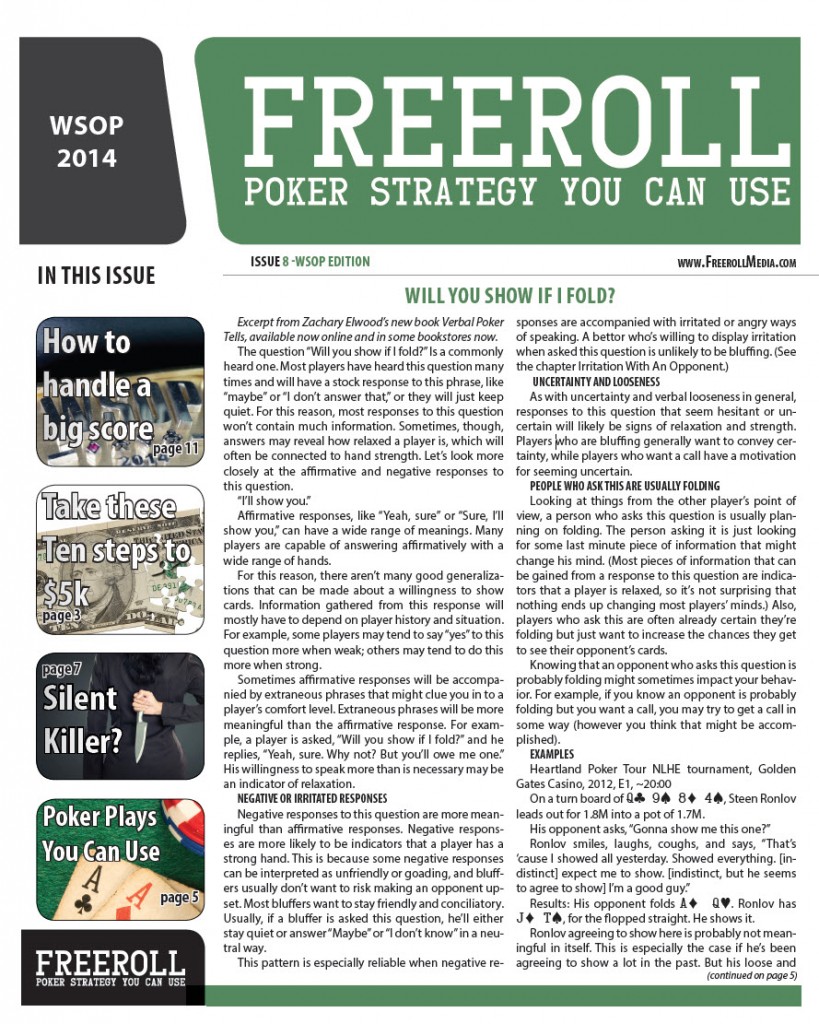Ten Skills To $5K
- By Ed Miller
- June 16, 2014
- Comments Off on Ten Skills To $5K
I believe almost anyone can win $5k playing live poker if they work hard enough and on the right things. And I’m not talking about luckboxing a tournament for a $5k score. I’m talking about grinding it up a few hundred at a time playing $1-$2 and $2-$5 level live games.
The beauty of doing it this way, of course, is that it’s repeatable. If you have the skill to win your first $5k at these levels, you likely can do it again. Once you have this level of proficiency, no-limit hold’em becomes a very satisfying endeavor.
To get to that level, however, I believe that you need ten distinct skills. Here they are, rapid-fire style.
1. See the big picture.
Most people choose a game to play without thinking too much about it. They go to their normal room, put their name on the list for the stakes they usually play, and then they go play the game they get called to.
Beyond that, most people just kind of play hands as they come. They sit and make decisions on one hand and then the next with little thought to the bigger picture.
To succeed, you need to understand the big picture. How are you going to make money doing what you’re doing? Where is the money going to come from? And what tweaks should you make to your normal routine to maximize that money source? Strong players think this way every time.
2. Play tight preflop.
In live no-limit games, nearly everyone plays too loosely preflop. Since it’s a near universal disorder, on one level you put yourself at no disadvantage by also playing too loose. But on the flipside, you can gain an immediate, inherent advantage if you play tighter than everyone else.
Some players are so confident with the rest of their game that they feel they can play loose and take advantage of it. But the vast majority of $1-$2 and $2-$5 players would improve immediately if they played tighter.
3. Bet your hands.
This skill is one that many players at the level have begun to master, but it warrants mention. When you make a hand, by-and-large, you need to bet it.
Also, you frequently need to be decisive. You need to decide which hands are strong enough that they need to be bet, and which ones fall short of that and don’t need to be bet. Many players try to split the difference with the hands in the middle (e.g., top pair of aces with no kicker) by making small-sized probing bets. This strategy has its place against the weakest players, but if you try it against better players you will be immediately pummeled.
The bottom line? You need to learn which hands demand bets and bet them.
4. Lay hands down to big turn or river bets.
When your opponents bet big on the turn or river, they’re betting a polarized range. That is, they either have a very strong hand, or they’re bluffing. Most players at the $1-$2 and $2-$5 levels do not make big bluffs often enough, compared to what is theoretically correct. Thus, it is generally correct to lay down all of your bluff-catching hands to these bets. And in this case, any hand that is worse than what your opponent would require to make such a large bet is a bluff-catcher.
This rule can demand you fold hands like top pair, two pair, and sometimes even trips or small flushes.
5. Bet the turn.
Since most people play too many hands preflop, they end up with too many weak hands after the flop. If you’re caught with too many weak hands, you can do only one of two things with them: call them down to showdown, or fold. In today’s game, many players choose to fold most of these hands. The turn is a key point in the hand—many of these players will “take one off” on the flop with a fairly wide range, but when the hands remain weak on the turn, they fold.
Thus, you should bet the turn. If it’s checked to me, in most $1-$2 and $2-$5 games I need a compelling reason not to fire the turn.
6. Bet after your opponents give up.
Whenever your opponent has been driving the betting, the hand can play out one of two ways. He can bet all the way to the river. Or he can give up short of that, checking in a spot he could have bet. When your opponents give up on their betting initiative with a check, you should bet. Unless your opponent is far trickier than most, this pattern of giving up indicates that a bluff will succeed often enough to be automatically profitable.
7. Look for bet-sizing tells.
Players at the $1-$2 and $2-$5 level often size their bets based on how they feel about their hand or on what they’re trying to accomplish. If you pay attention to the sizes they choose, you can frequently reverse-engineer the bet to narrow down ranges or to detect weakness or strength. For example, players at this level are not making small bets on the turn on a draw-heavy board with a set. Bet-sizing tells carry information that can give you a large edge.
8. Draw hands out.
The typical $1-$2 and $2-$5 player is uncomfortable playing substantial pots on the turn and river. Resist the urge to end hands early, for instance by shoving the flop. Most of the advantage you can generate at these levels depends on your opponents betraying too much information about their hands. Unless you have a compelling reason to do otherwise, it’s usually best to keep throwing the action back to your opponents. For example, your opponent can’t give you bet-sizing tells if you just shovel your chips in the middle at the first opportunity.
9. Be consistent.
Consistency is paramount. Think about restaurants. All successful chain restaurants go to great lengths to make sure that when you order a menu item, it is virtually exactly the same no matter whether you’re in Miami or Montana. It’s not spicier or sweeter. It’s not more or less cooked. It’s identical every time. Without this consistently, people wouldn’t trust the restaurant and it would fail.
You have to be just as consistent every time you play poker. You should play exactly as tight preflop every time. You should always bet your hands. You should always lay down to big bets. And so on. Yes, I understand that game conditions change, but many players at the level use the excuse that they’re “adjusting” to opponents to excuse lax, lazy, and ultimately losing play.
My game is remarkably consistent from table to table and from week to week. In my opinion, consistency in your play is absolutely vital.
10. Practice every day.
If you want to be successful at poker, you must practice on a near daily basis. You don’t have to put in live sessions every day (though it helps). But you must work on your game every day. The best way to work when you aren’t playing is to analyze a hand you’ve played. Reading and watching videos also helps. If you resolve to work every day to get a little bit better, you will give yourself the best chance to win your first $5k.



